“The big thing I learned in World War II was the urgent necessity of frequent visits … I was abreast of what was going on all over the place. I could sense their reactions and I could see how they felt urgently about this or that, which we at headquarters did not really feel so much, but I would come to an understanding in those ways and I could correct things almost instantly,” Gen. George Marshall told his biographer in 1957.
His travel records bear this out his desire to frequently visit both training and combat areas. Marshall spent the first half of April in London at a conference; flying out April 4 and back April 19. Just 11 days later, he began a 2 ½ day tour of bases in the southeastern United States.
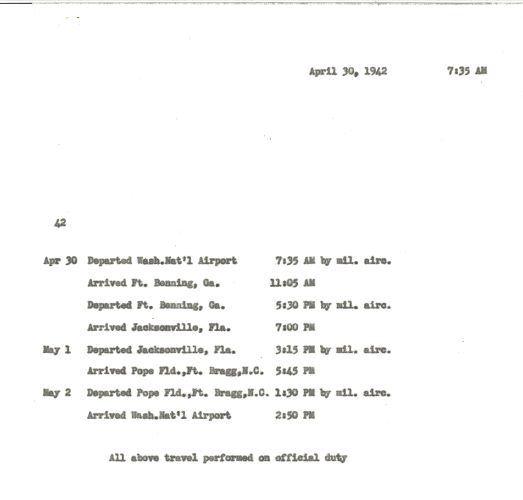
Travel orders for Gen. Marshall and his party by military aircraft.
Marshall and British Field Marshal John Dill traveled April 30 from Washington, D.C., to Fort Benning, GA; Camp Blanding, FL; and Fort Bragg, N.C., and returned to Washington, D.C., May 2. They visited with officers in each area, and more importantly, troops in the field.
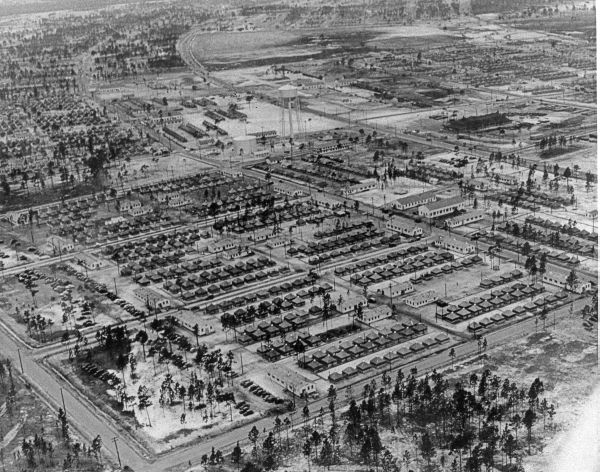
Aerial view of Camp Blanding
Camp Blanding, comprising 30,000 acres, was founded in 1939 for the Florida National Guard. When the Florida Guard was federalized, so was this training area. Between 1940 and 1943, the 1st Infantry, 29th Infantry, 30th Infantry, 31st Infantry, 36th Infantry, 43rd Infantry, 63rd Infantry, 66th Infantry, and 79th Infantry divisions, and other units, trained there and this influx of soldiers made Camp Blanding one of the largest cities in Florida.
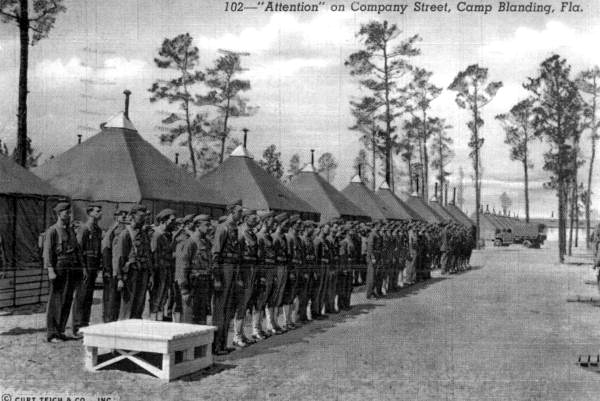
While in garrison, soldiers slept in pyramidal tent buildings.
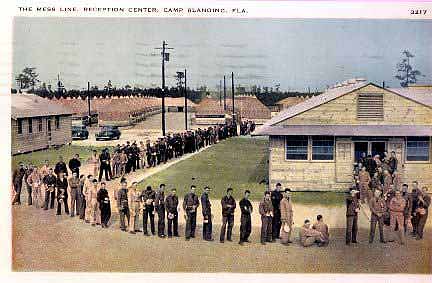
With so many soldiers on post, mess hall lines were very long as shown by these hungry 508th Parachute Infantry Regiment soldiers.
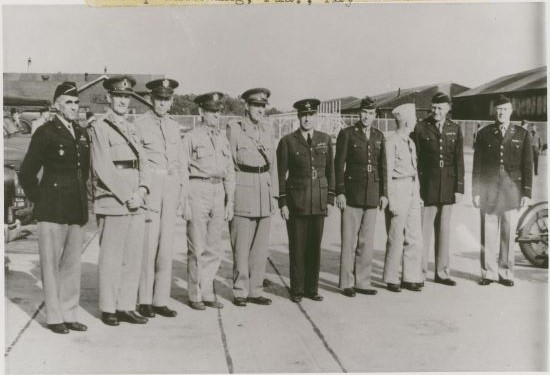
Gen. Marshall with Gen. Lesley McNair, Lt. Col. Terry Allen, Field Marshal John Dill, and others.
At Camp Blanding, Marshall saw and talked with former Infantry School student and fellow horseman, Lt. Col. Terry de la Mesa Allen, who was serving there at the time.
Marshall and Dill spent time learning from unit commanders in the training areas. These commanders had to be prepared for Marshall’s questions; he expected them to be very involved in training. The soldier wearing the “Daisy Mae” hat is carrying a much-need canteen in the Florida heat and humidity. Most soldiers, including officers, still wore the short WWI-era Pershing boot with gaiters, as the M-1943 combat boot was not yet widely available.
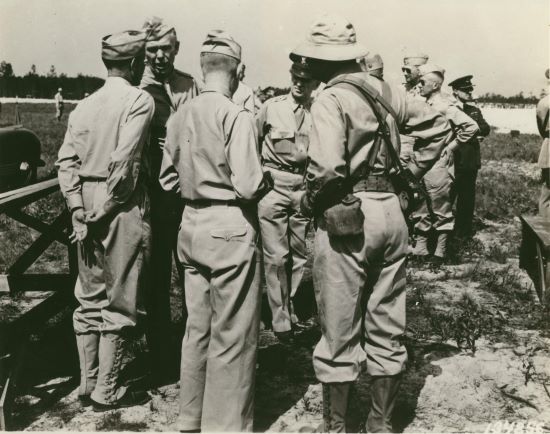
Marshall talks with officers as McNair listens to the conversation.
Marshall and Dill witnessed training in the cantonment area to include communications. Marshall is talking with a soldier wearing mostly World War I-era gear.
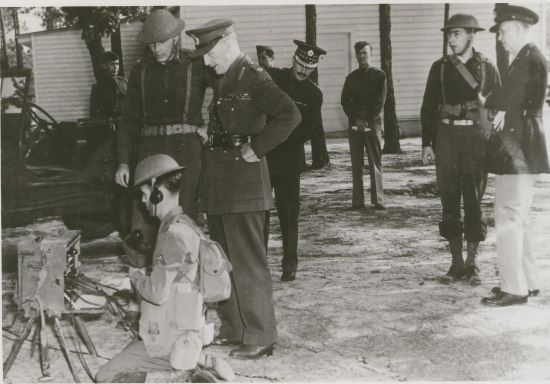
Dill observes a soldier using a field telephone switchboard.
They also saw training in the field, which was flat, sandy, filled with palmetto and long-leaf pine, and a lot of bugs. Because of the temperate weather in Florida, training could progress year-round, which made this training ground valuable to the U.S. Army.
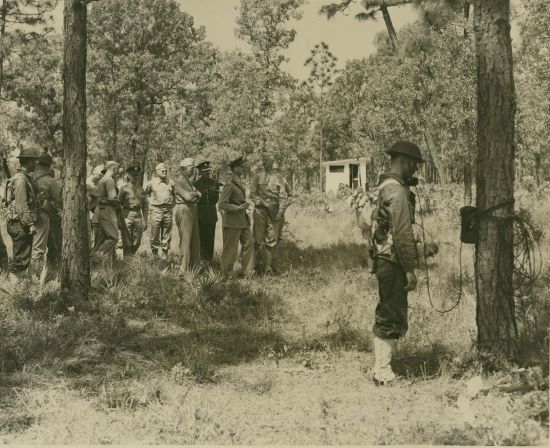
A soldier in a World War I-era helmet using a field telephone mounted to an omnipresent longleaf pine tree.
Although Marshall spent a lot of time talking with commanders of the various units training at Camp Blanding, by far his favorite thing to do on these visits was talk to the soldiers on the ground, or in this case from the air.
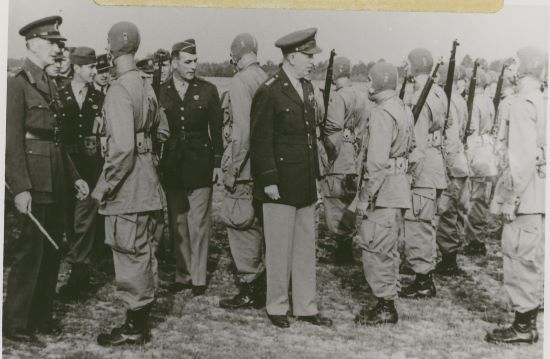
Marshall and Dill converse with airborne soldiers from the 503rd Parachute Infantry Regiment, wearing the summer cloth flying hat normally seen on Army Air Corps crews and not altogether different from Snoopy’s pilot cap.
These visits by Marshall, often accompanied by Dill, did more than raise morale and expectations. They keyed Marshall into important things that did not end up on the reports that wound their way up the chain of command to the Chief of Staff. He preferred to make choices and decisions based on what was really happening, and not just what was reported happening.
Aerial view of Camp Blanding from Florida Memory
Tent photo from Ray City History
Mess hall photo from 508th PIR Association
Melissa has been at GCMF since Fall 2019, and previously was an academic librarian specializing in history. She and her husband, John, have three grown children, and live in Rockbridge County with two large rescue dogs. Keep up with her @life_melissas.
